Growing strawberries is a great way to add fresh fruit to your home garden, and it couldn’t be easier. That’s why I’ve designed this detailed care guide for you.
I’ve included information on everything from water, sunlight, soil, and fertilizer, to pruning, harvesting, managing pests, and much more.
Quick Strawberry Plant Care Overview
| Scientific name: | Fragaria x anannassa |
| Classification: | Fruit |
| Common names: | Strawberry |
| Hardiness: | Zones 3-10 |
| Temperature: | 40-80°F (4.4-26.6°C) |
| Flowers: | White, pink, or yellow, blooms spring-summer |
| Light: | Full sun to light afternoon shade |
| Water: | Keep soil evenly moist, do not overwater |
| Humidity: | Average |
| Fertilizer: | Fruiting plant food spring-summer |
| Soil: | Rich, fertile, well-draining |
| Common pests: | Slugs, weevils, beetles, fruit flies, thrips, birds, rodents |
Information About Strawberries
Strawberries (Fragaria x anannassa) are a cold hardy, fruit-bearing perennial plant that’s native to South America.
They are known for their thick green foliage and red, sweet fruits, and they make a lovely ground cover. The oval-shaped, fuzzy, serrated leaves and flowers grow on thin stems.
Blossoms typically appear in the spring and are most commonly white, but can also be pink or yellow.
They’re prolific spreaders that can quickly fill up a flower bed or container. After fruiting, they send out runners, or tendrils, that will develop into new ‘daughter’ plants wherever they touch the ground.
Different Types
There are three main categories of strawberry plants, and each has many varieties with subtle differences in temperature tolerance, disease resistance, and more.
Start by choosing the type you’d like to grow, then select the proper cultivar for your climate and garden.
- June-bearing – This type is known for a prolific once-per-year harvest of large, sweet berries. It sets fruit in early to mid-summer and the harvest lasts about 3 weeks. Popular varieties include the Jewel, Honeoye, Allstar, and Cavendish.
- Everbearing – This one can produce throughout the entire season, but usually has two main fruiting periods: the first in late spring and the second in early fall. They tend to have fewer runners and smaller fruits, but there are more cold-hardy options. Popular cultivars include Ogallala, Fort Laramie, and Quinault.
- Day-neutral – These plants produce fruit consistently throughout the growing season from spring through fall. They can produce a large yield overall, but each harvest is generally fairly small. Look for the Seascape, Alpine, or Tribute varieties to try.
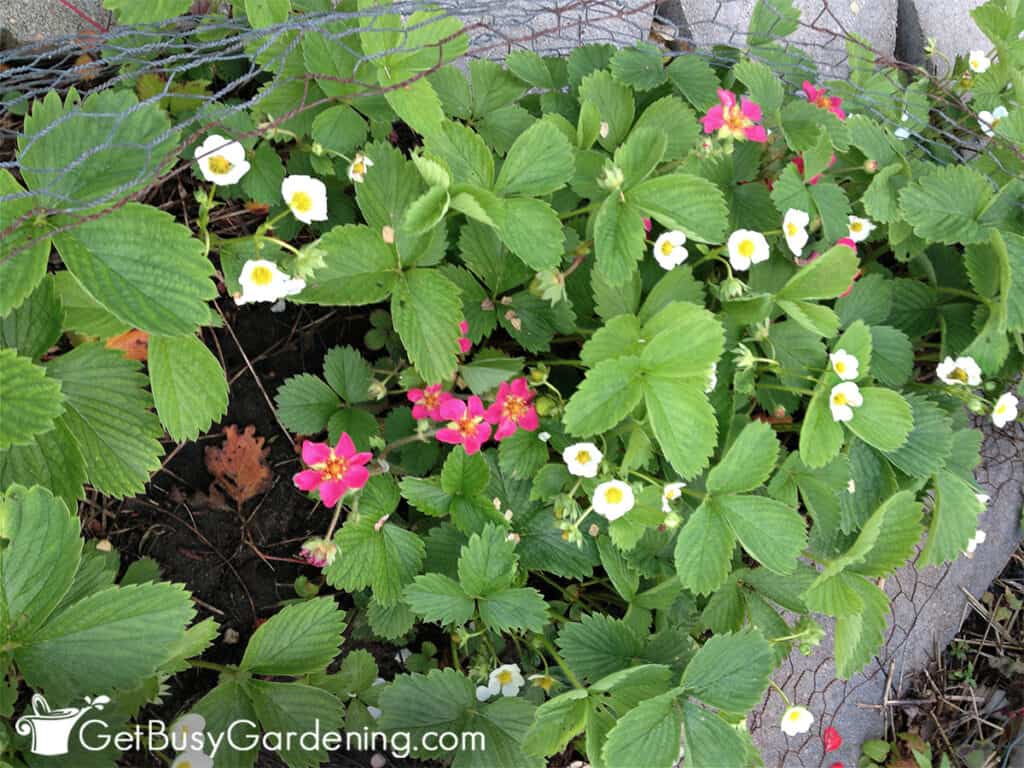
Hardiness
Strawberries are perennials in most zones. The exact hardiness range depends on the variety, but anyone in zones 3-10 can grow them.
The plants prefer a cool environment, and will struggle in the heat – especially in hot, dry climates. So if you live in a warmer region, make sure yours gets afternoon shade and regular waterings.
How Strawberries Grow
The fruits form on self-fertile flowers after they’re pollinated by bees, insects, or the wind. The tiny fruits start out yellow or green, fade to white, and then become deep red when they’re fully ripe.
They will begin to form in the center of the flower shortly after pollination, and it takes about 4 weeks before they’re fully ripe.
More blooms will continue developing, even as the strawberries begin to ripen. So check back daily to pick the mature ones, which can help encourage the plant to keep producing more.
Related Post: How To Can Strawberries
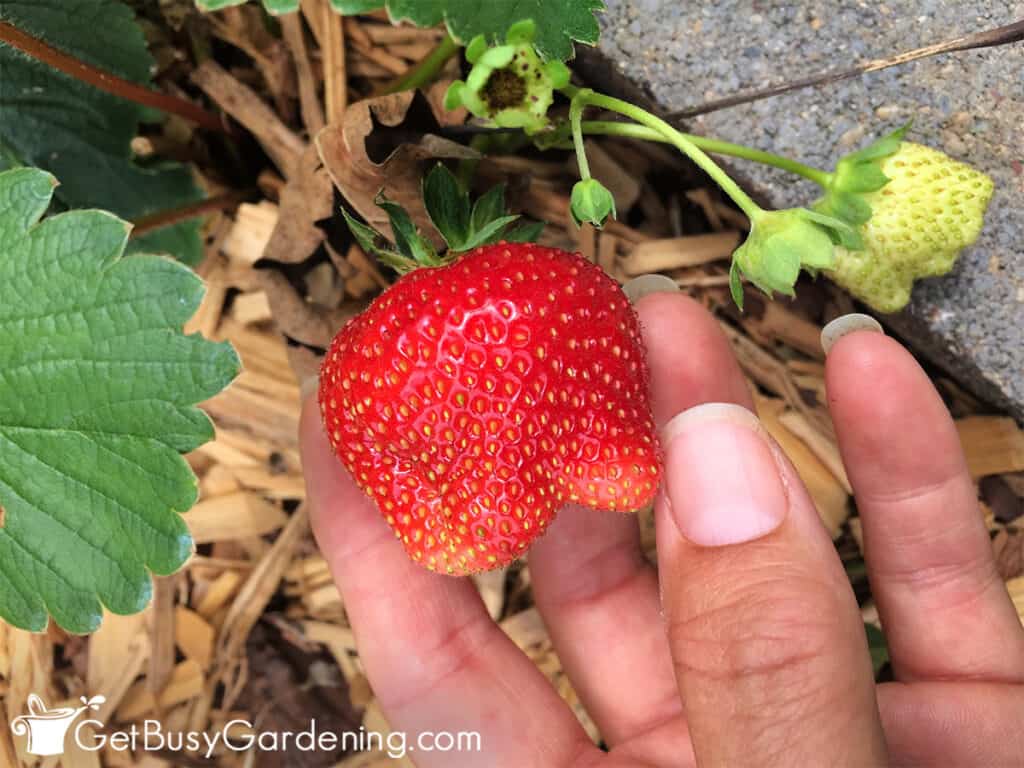
How To Grow Strawberries
Before discussing the proper care, we should talk about where and when to grow your strawberries first. The right timing and location are critical to a bountiful yearly harvest.
Where To Grow
The best location for your strawberries is somewhere that gets full sun and has fertile, well-draining soil.
Make sure to leave 8-12” of space between each crown so they have plenty of room to spread. They do great in raised beds and containers too, which makes them easier to control.
When To Plant
Plant your strawberries when it’s consistently above 40°F (4.4°C), or as soon as the ground is workable in early spring.
Ensure the crown sits just above the soil line. Planting them too deep can lead to rot, but if they’re too high the roots can end up drying out.
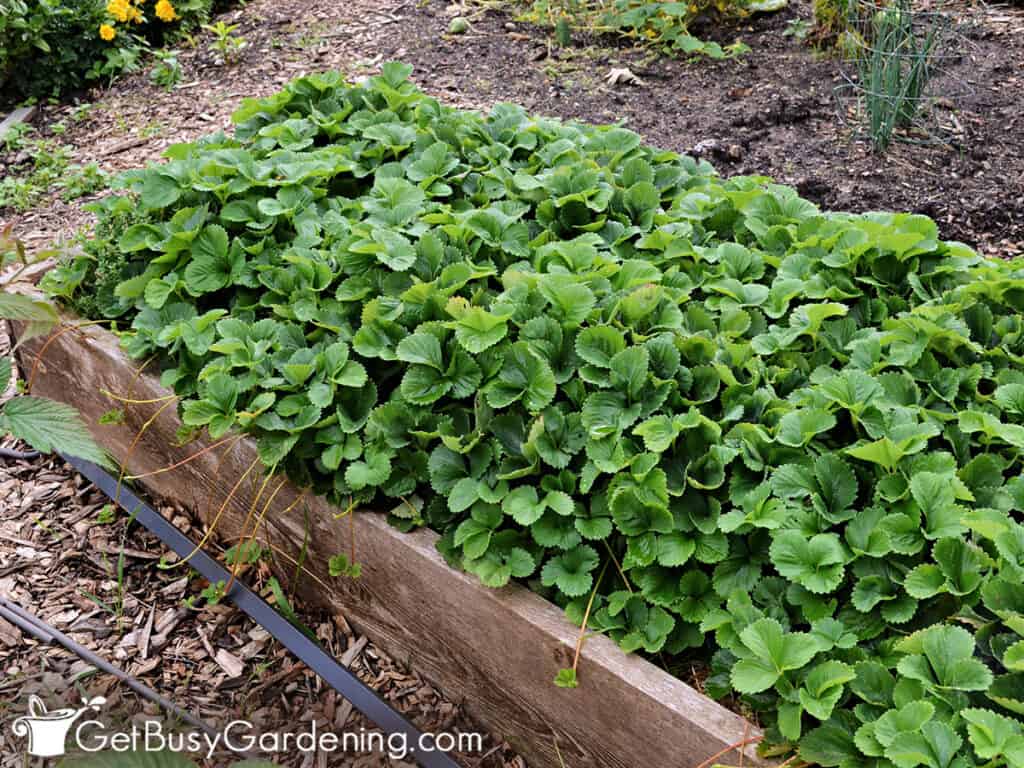
Strawberry Plant Care & Growing Instructions
Now that you have the perfect growing location picked out, it’s time to talk about how to care for your strawberries. My tips below will help make them a simple and prolific addition to your garden.
Sunlight
Strawberries need a minimum of 8-10 hours of full sun daily. Too much shade can inhibit growth, flowering, and fruiting.
If, however, it regularly gets above 85°F (29.4°C) in the summer where you live, use a shade cloth to protect your plants from the intense afternoon sun to prevent wilting.
Water
Strawberries like even and consistent moisture, and do not like to be over or under-watered. Aim to provide at least 1” per week from spring through fall.
You’ll need to irrigate more when your plant is blooming, sending out runners, and during the late fall when it stores energy for winter. If you have trouble getting the amount right, a moisture gauge is a useful tool that can help.
Always water near the base of the plant to avoid splashing soil or moisture sitting on the leaves, both of which can lead to disease or fungal problems.
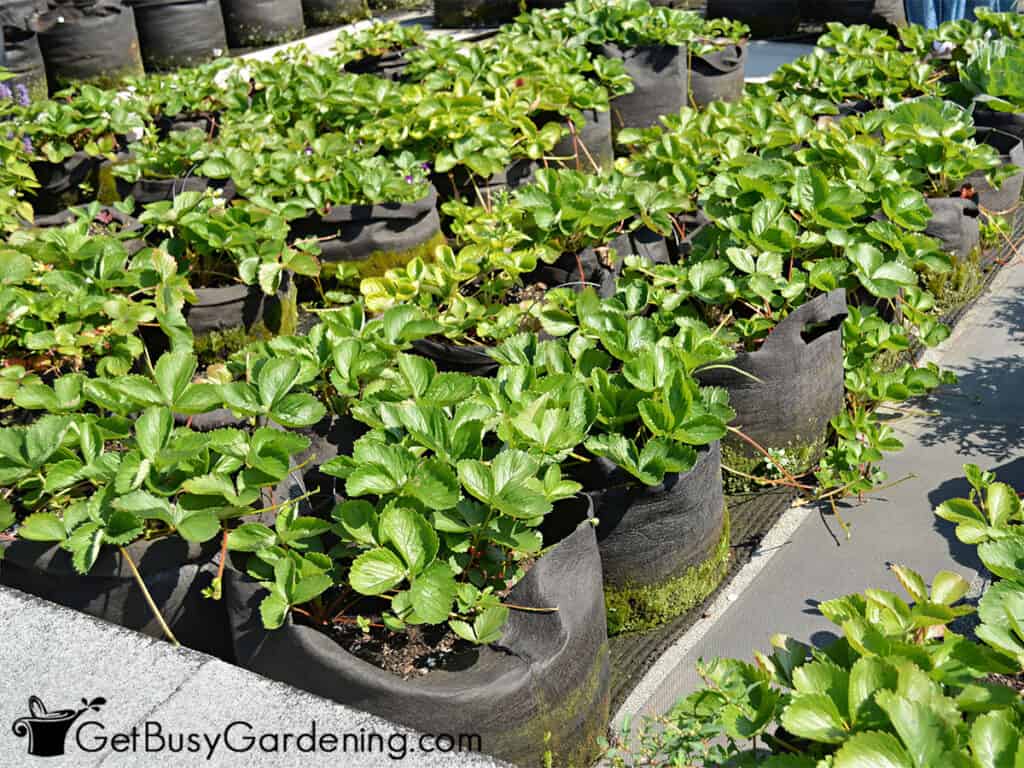
Temperature
Strawberries grow best when it’s between 60-80°F (15.5-26.6°C). The foliage will begin to go dormant at around 35°F (1.6°C) or lower.
If it gets colder than that where you live, cover the crowns with a 4-6” layer of mulch, such as shredded leaves or clean hay, to protect them from extreme winter weather.
High heat can quickly wilt the foliage, cause flowers to drop off, and damage existing fruits. So provide shade during the afternoon if it’s going to be above 85°F (29.4°C) for an extended period of time.
Fertilizer
Regular feedings of an all-purpose or fruiting plant fertilizer are a great way to help maintain the soil nutrients in your strawberry patch.
Start applying liquid options, like compost tea or fish emulsion, in early spring once you see new growth, and repeat every 2-4 weeks through the end of summer.
If you prefer, you can apply slow-release granules or side-dress with compost or well-rotted manure in the spring and summer.
Soil
Strawberries grow best in a rich, well-draining, and slightly acidic medium with a pH of 5.5-6.8, which you can check with a soil probe.
Amend garden beds with compost or well-rotted manure to help improve fertility and drainage. For containers, choose a loamy, rich, high-quality potting soil.
Related Post: How To Make Strawberry Jelly
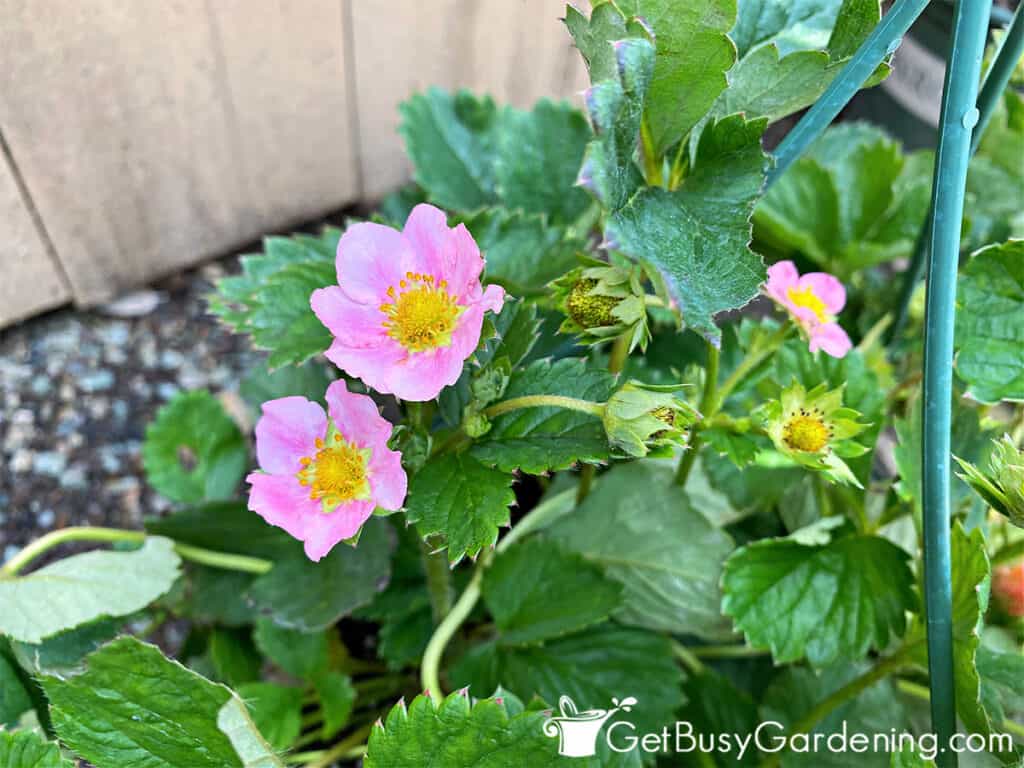
Pruning
Pruning is a key part of long-lasting health, pest management, and controlling the runners. Strawberries are prolific spreaders but, though they can multiply and grow quickly, they’re easy to manage.
So trim off any offshoots you don’t want with clean, sharp precision pruners as needed to prevent them from overtaking your garden.
Once the foliage starts to die back in the fall, remove all of the dead leaves. This helps prepare them for winter, and rejuvenates them for new growth in the spring.
Pest Control Tips
Unfortunately, many bugs and animals enjoy the sweet taste of strawberries as much as we do. Weevils, slugs, thrips, spotted wing drosophila, rodents, and birds are some of the most common offenders.
The best method of control is prevention. Keep your plants clear of debris from old leaves, dying foliage, fallen or rotten fruit, weeds, and old mulch. An insecticidal soap, slug bait, or diatomaceous earth can also help to control bugs.
For animal pests, bird netting or row covers are helpful, but wait until after flowering to apply them, or they can inhibit pollination.
Disease Control Tips
Strawberries are prone to several diseases and fungi, such as leaf spot viruses, powdery mildew, gray mold, root and crown rot, and verticillium wilt.
Discolored or spotted leaves, misshapen fruit, gray or white furry growth, or soft, brown rotting stems and fruit are signs that your plant may be infected. While a fungicide may help slow the spread, prevention is key.
Keep the ground between your plants covered with clean mulch and clear of dead or rotting foliage or debris. Prune them regularly to maintain air circulation, and always water properly to prevent moisture from sitting on the leaves.
Tips For Harvesting Strawberries
Wait until the fruits are entirely red before harvesting them. Don’t pick any with white edges, shoulder, or tips. But do not leave fully ripe ones on the plant for too long, or they could begin to rot or attract pests.
The exact timing and duration of your harvest will depend on the type of strawberries you grow. Look for red fruits in early to mid-summer, or about 4 weeks to one month after flowering starts.
Use clean, sharp micro-snips to cut the ripe strawberries from the stems just above the leaves, as pulling them off can damage the crown. Store your crop unwashed in the fridge for the longest shelf life.
Related Post: How To Can Strawberry Jam
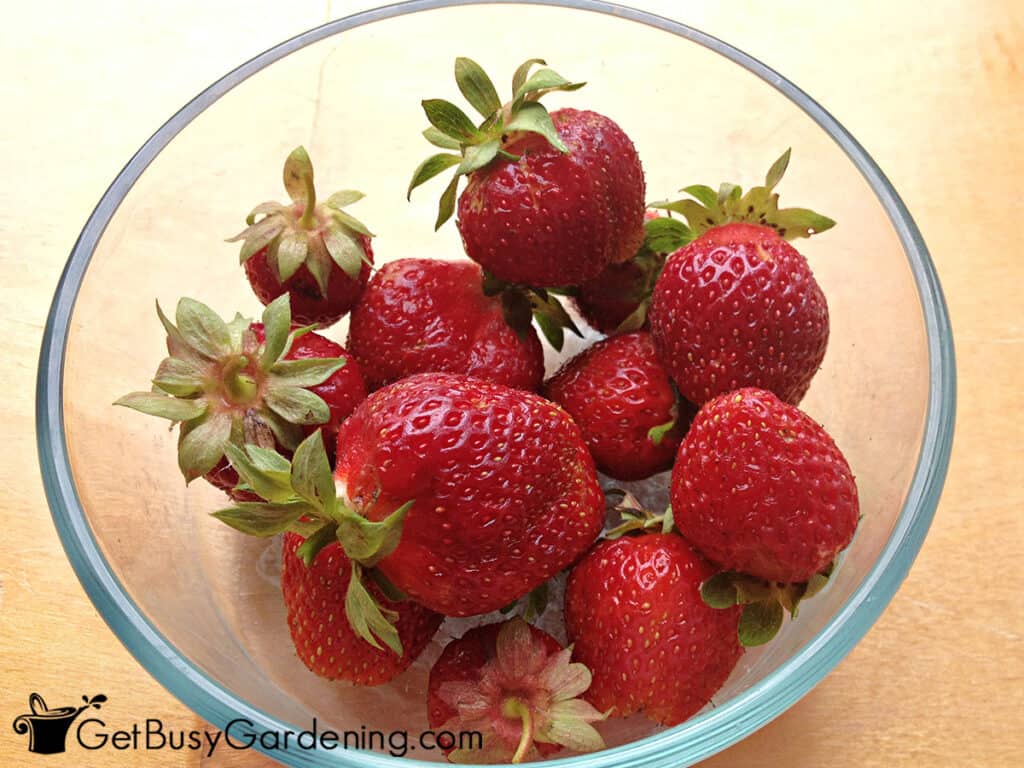
Troubleshooting Common Problems
Strawberries are easy to grow once you understand what they need, but there are several common issues that you may face. Use these tips to help get your plants back on track.
Wilted Leaves & Stems
High temperatures, overwatering, root rot, and drought are common causes of wilting and limp foliage.
Give your plant shade in the afternoon when it gets above 85°F (29.4°C). Ensure the soil is consistently moist and not soggy, but never leave it bone-dry for extended periods.
Brown Leaves
Improper watering, disease, pests, high temperatures, or too much fertilizer could all be causes of brown leaves on your strawberries.
Keep the soil moist without leaving the plants in standing water. Provide shade in the afternoon during high heat, and reduce how often you’re fertilizing, or try diluting the dose.
Soft, Mushy Fruit
Over-ripened strawberries, wet growing conditions, or diseases can all lead to mushy fruit.
Pick them as soon as they’re red, maintain proper air circulation with consistent pruning, and irrigate at the base of the plant rather than overhead.
Holes in Fruit
Large holes or chunks missing in your strawberry leaves or fruits are a sign of bugs, birds, or rodents feasting on them.
Apply a bird net or row covers to deter animals, and regularly clean the area around the plants to reduce areas for bugs to hide.
Spotted Leaves
Many forms of leaf spot disease can affect your strawberries. They cause red, orange, purple, black, or brown spots to appear on discolored leaves. It may look bad, but it’s not usually harmful to the fruit.
Proper watering and plant maintenance are the keys to keeping them healthy. Once affected, prune away any damaged fruit or foliage and apply an organic fungicide to prevent the spread.
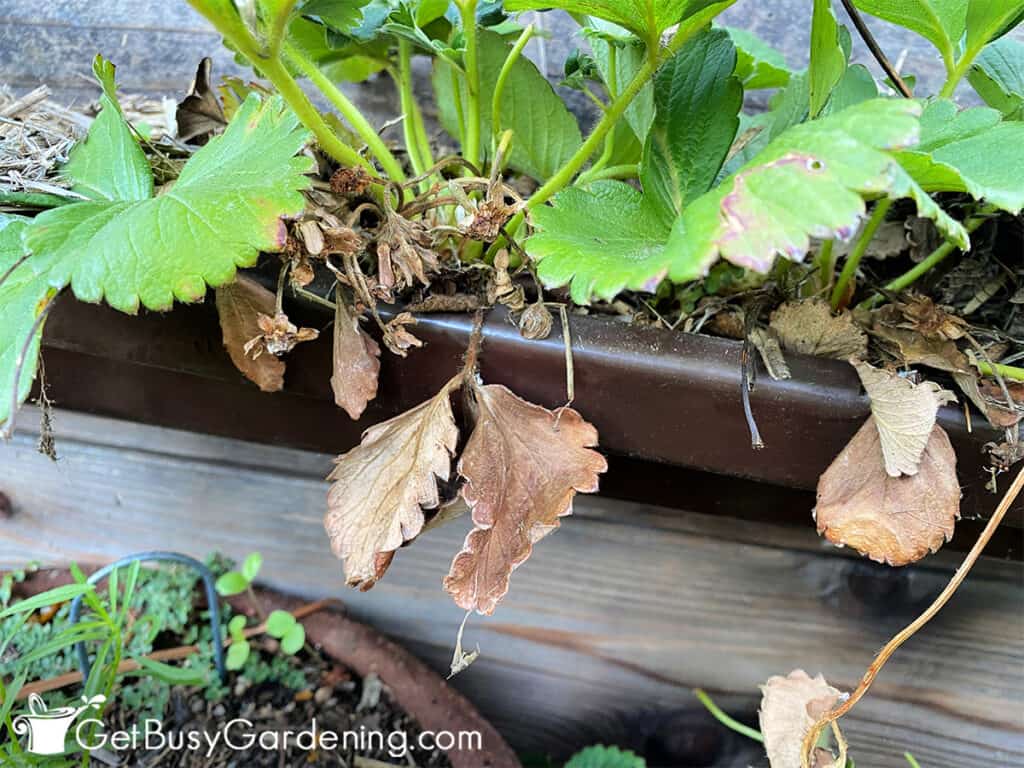
FAQs
A strawberry plant can produce fruit in the first year of growth. Once bees or wind pollinate the flowers, it takes about 4 weeks for the fruits to fully ripen.
Yes, they are very easy to grow in the right environment. Choose a variety that’s hardy in your zone and plant it in a full sun area with rich, fertile, and slightly acidic soil. Keep them evenly moist, water at the base to prevent soil-borne diseases, and trim them regularly for the best success.
Yes, strawberry plants come back every year in growing zones 3-10. They typically bear fruit for 3-5 years, with reduced yields as they age. Allow runners to root and produce new plants annually to replace older ones.
Yes, they spread via runners. They send out rooting tendrils after fruiting has finished. June-bearing types produce the most runners, but all varieties can spread this way.
If you’d like to learn how to make the most of your space and get as much homegrown food as possible, then my Vertical Vegetables book is perfect! It will teach you all you need to know, has tons of gorgeous photos, and includes 23 DIY projects you can build for your own garden. Order your copy today!
Learn more about my Vertical Vegetables book here.
More About Growing Fruit
Share your tips for growing strawberries in the comments section below.


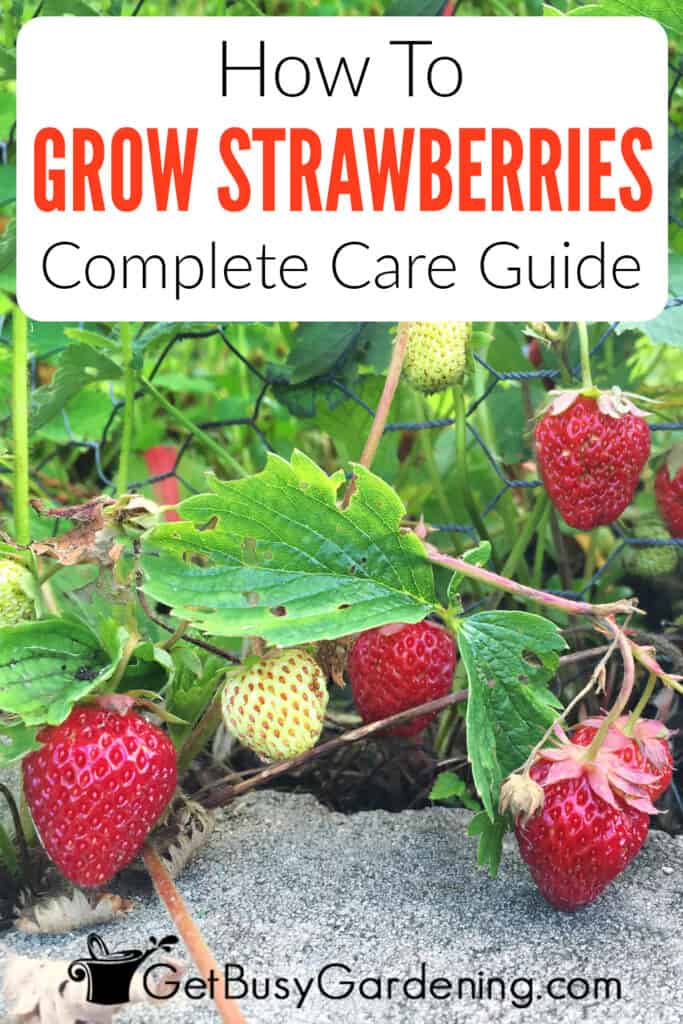
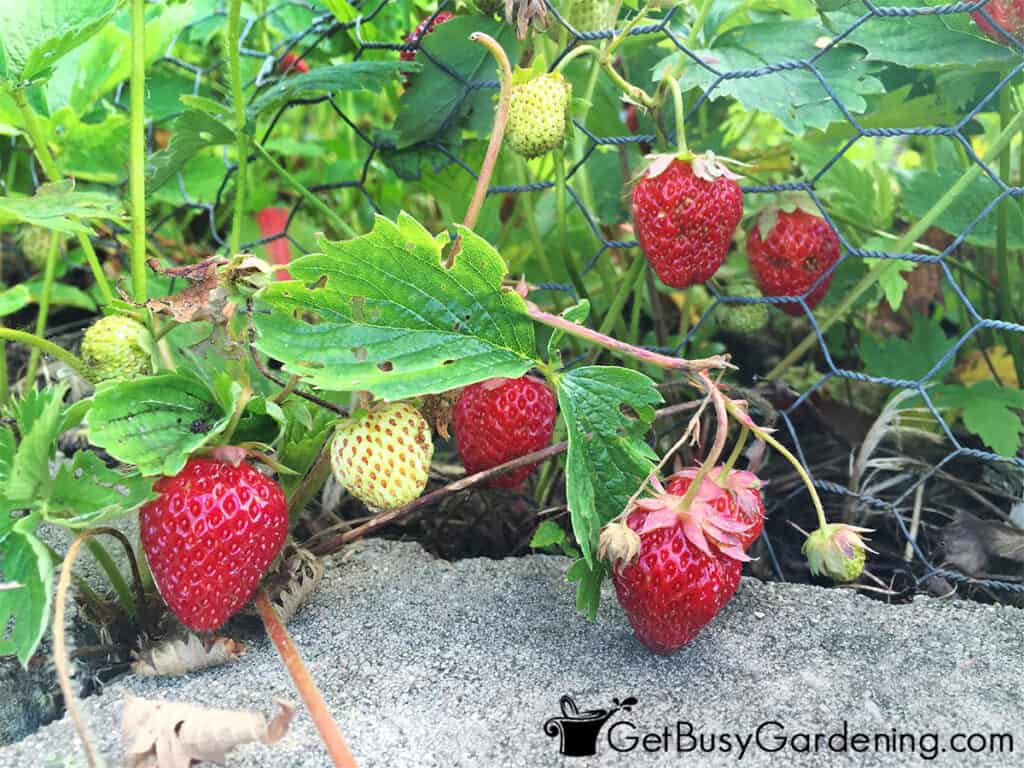


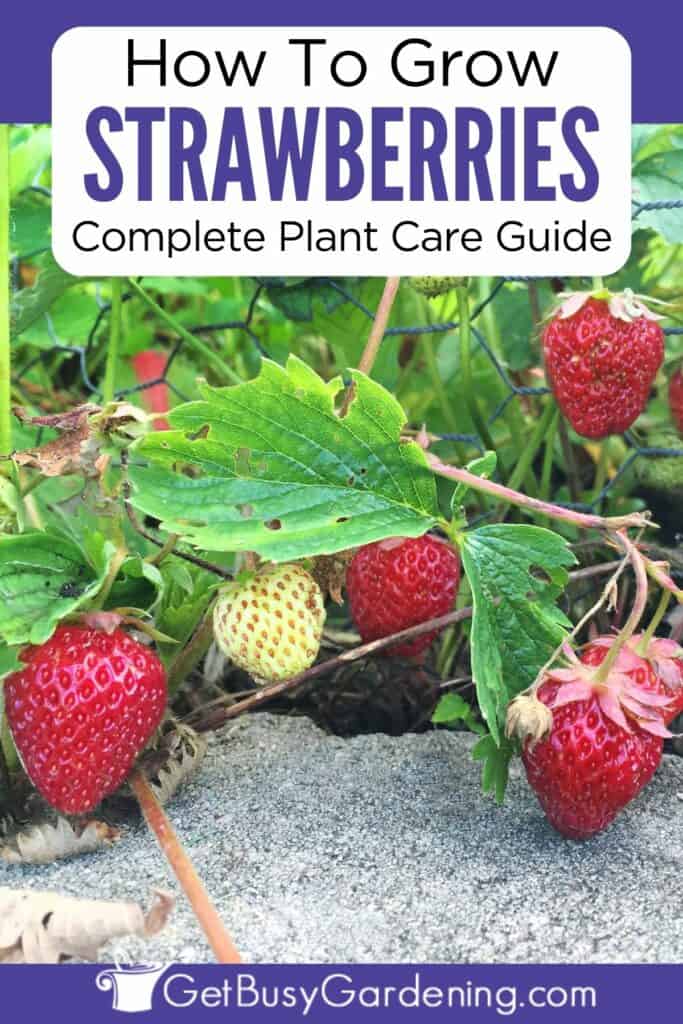

Leave a Reply